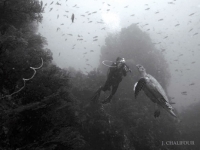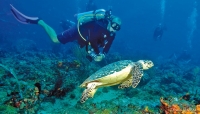The sites were visited twice a week by the staff and the eco-volunteer partners of the Réserve, for a total of 310 visits.
The hawksbill turtles were more numerous in terms of laying their eggs on the beaches of Saint Martin, while the rarer leatherbacks left just one trace on the beach at Long Bay and a nest on the beach in Orient Bay without evidence of eggs as the turtle was most likely disturbed by light and people (see issue n°12 of this Journal, which you can download at www.reservenaturelle-saintmartin. com).
The sea turtles prefer the beaches at the lagoon on Tintamare, Coralita, and Long Bay.
Julien Chalifour, director of the scientific department for the Réserve, has noted an overall regression in the number of turtles seen since 2009, especially on the beaches of the Lowlands. However, the same generation of sea turtles only lays eggs every other year, so this trend could reverse itself this year. At the same time, the diving clubs in the INASCUBA network observed 222 sea turtles during 312 various dives on 30 different sites, with the height of the sightings in February 2011. As a matter of course, at the end of each dive, the clubs fill out a form indicating the number of sea turtles that were spotting, as well as their species.
The “Sec de Grand-Case” of the French side, Charlie Shoal and Proselyte Reef on the Dutch side, hold the record for the most sea turtles, yet even here their numbers are slightly lower.
There were also fewer dive clubs participating, as the follow-up takes a certain amount of time every day. As a result the Réserve is once again going to try and mobilize the professional divers.
Most of them were trained on March 5 in the monitoring protocol and thus can identify traces of turtles that come to nest on the beaches, and differentiate the species. A second session was organised in late March, just before the hieght of the egg-laying season in April.



















